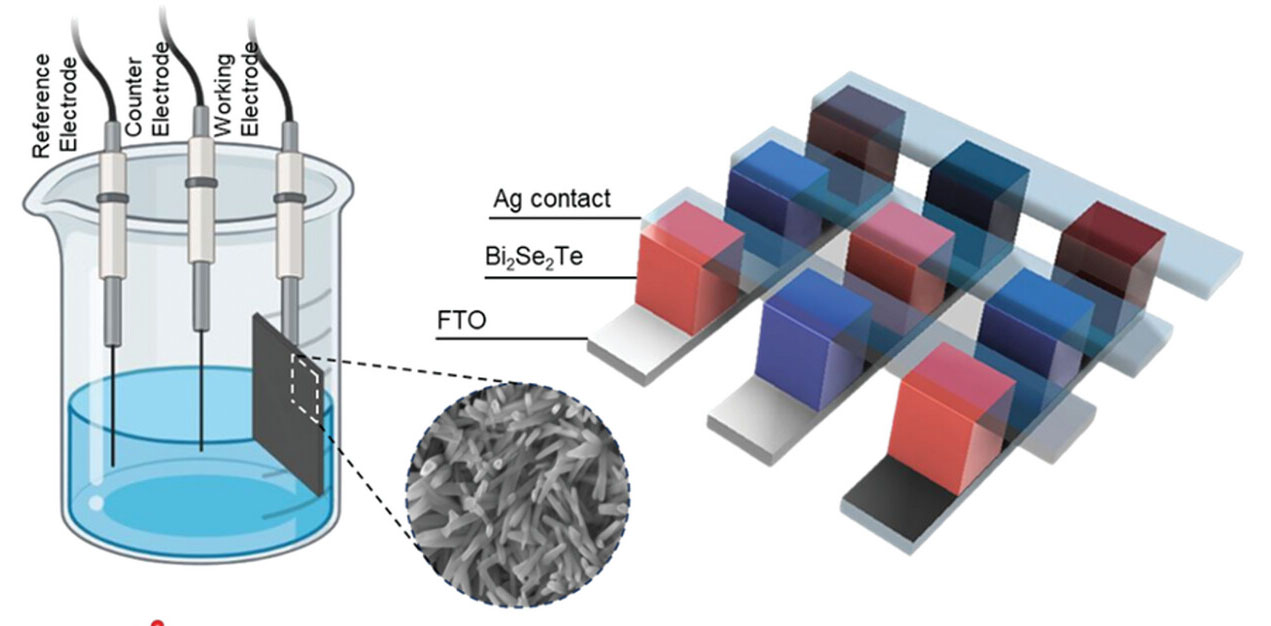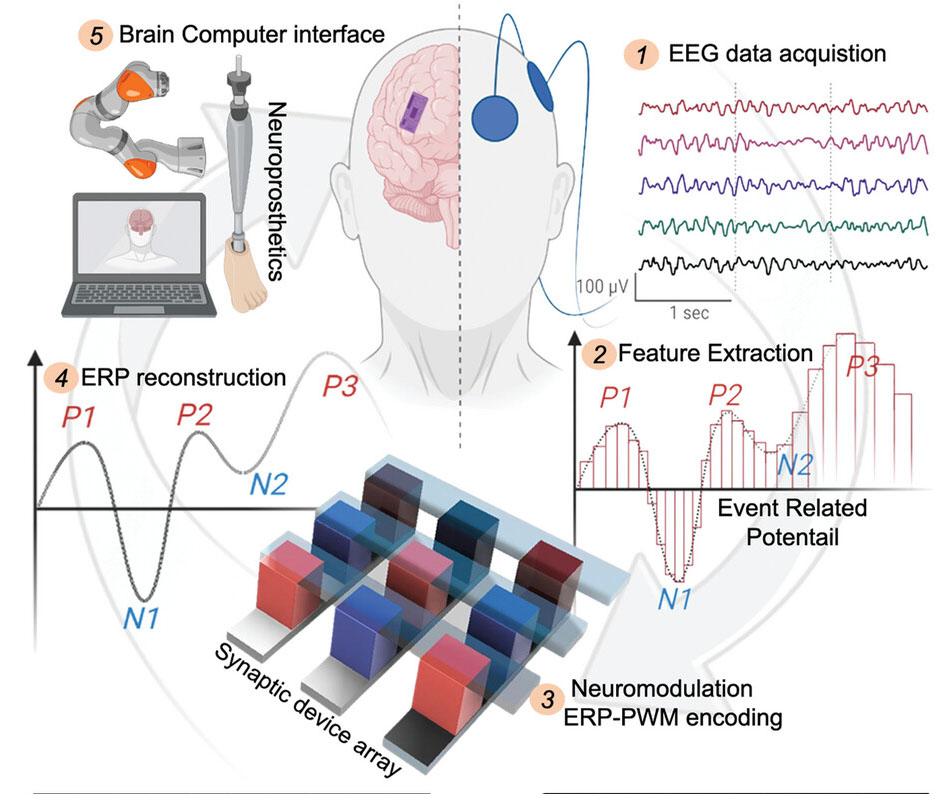| May 15, 2024 | |
Quantum neuroelectronic devices emulate brain synapses, show potential to mitigate cognitive decline |
|
| (Nanowerk Spotlight) The complex neural networks of the human brain, with their trillions of interconnected neurons communicating via synapses, endow us with unparalleled cognitive abilities. Yet the inevitable march of time takes its toll, as aging and neurological disorders lead to cognitive decline by disrupting the delicate synaptic signaling that underlies learning and memory. | |
| While the immense complexity of the brain has long stymied efforts to halt or reverse this decline, an innovative approach fusing cutting-edge technologies from the seemingly disparate fields of quantum materials and neuromorphic engineering is now showing promise. | |
| In a significant step forward, a research team in Hong Kong has developed a first-of-its-kind neuroelectronic device that emulates key aspects of biological synapses by leveraging the exotic properties of a quantum material known as a topological insulator. | |
| This pioneering work, published in Advanced Materials ("Topological Quantum Switching Enabled Neuroelectronic Synaptic Modulators for Brain Computer Interface"), which harnesses phenomena from the strange world of quantum physics in service of real-world applications, opens up new possibilities for influencing neural activity to potentially reduce cognitive decline. | |
 |
|
| Bismuth selenide telluride material fabrication and characterization. Demonstration of the electrochemical deposition (ECD) method to fabricate the synaptic device array. (Reprinted from DOI:10.1002/adma.202306254, CC BY) | |
| The foundation for this advance is bismuth selenide telluride (Bi2Se2Te), a topological insulator material that exhibits unusual electronic states on its surface. Unlike conventional insulators, topological insulators act as electrical insulators in their interior but conduct electricity along their outer edges due to quantum mechanical effects. It is these edge states that prove pivotal for crafting devices that capture the essence of neuronal synapses. | |
| In the brain, synapses are the critical junctures between neurons where neurotransmitter chemicals are released to propagate signals. The strength of these connections can be dynamically adjusted, with repeated stimulation leading to a persistent enhancement called long-term potentiation that is believed to be a key mechanism of learning and memory. As we age, however, this synaptic plasticity diminishes, contributing to cognitive decline. | |
| The researchers recognized that by fashioning Bi2Se2Te into a device structure resembling a synapse, with silver electrodes on top and tin oxide electrodes below serving as the pre-synaptic and post-synaptic terminals, they could exploit the quantum properties of the topological insulator to mimic vital synaptic functions. Crucially, the surface electronic states could be modified by applying electric fields, providing a means to tune the device's synaptic behavior. | |
| Electrical characterization revealed that the unique properties of Bi2Se2Te enabled the artificial synapse to achieve low-power operation, with switching voltages comparable to the minute electric potential changes of biological neurons. By modulating the conductivity of the quantum material with voltage pulses, the researchers could produce post-synaptic current responses closely resembling those in the brain. | |
| Notably, the Bi2Se2Te synaptic devices exhibited a flexible modulation "index" that could be adjusted to emulate synaptic characteristics representative of different age groups. The devices could mimic the diminished plasticity seen in aging brains and could also be tuned to perform more like a healthy young brain. This capability suggests a future ability to non-invasively modulate cognitive function, though significant research remains to realize that vision. | |
| As a proof-of-concept demonstration, the team used their synaptic devices to modulate human brainwave data reflecting age-related cognitive impairment. By applying the devices' output to electroencephalogram signals, the distorted neural responses of elderly subjects could be altered to more closely resemble the patterns of healthy young adults. The results hint at the long-term potential of this technology for clinical applications, but major challenges must be overcome. | |
 |
|
| Real-time modulation of EEG–ERPs neural signals. a) Step-by-step illustration of neuromodulation process involving 1) EEG data acquisition, 2) ERPs feature extraction and signal sampling, 3) neuromodulation process using synaptic device, 4) signal reconstruction, and 5) brain computer interfacing as neuroprosthetic controls. (Adapted from DOI:10.1002/adma.202306254, CC BY) | |
| One key hurdle is the scalability of the synaptic devices. While the researchers have shown promising results with individual device units, practical applications would require integrating them into much larger networks that can interface with the brain's complex web of neural connections. Engineering solutions will be needed to enable the fabrication of high-density arrays of these quantum synaptic devices. | |
| Another critical consideration is the long-term stability and biocompatibility of the Bi2Se2Te devices. For chronic implantation in the brain, the devices would need to maintain their performance over extended periods without degradation. They must also be encapsulated in biocompatible materials that can shield the delicate quantum structures from the harsh biological environment while avoiding any adverse impacts on the surrounding neural tissue. Rigorous testing will be essential to validate the safety and efficacy of this technology for clinical use. | |
| Despite these challenges, the innovative fusion of quantum materials science and neuromorphic computing represents an exciting frontier. By creating devices that can directly interface with the brain's electrical signaling while harnessing the exotic properties of topological insulators, this work establishes a foundation for future technologies that may one day help to alleviate the burdens of cognitive decline. Through precise modulation of neural activity enabled by quantum-engineered synaptic devices, we may gain new tools to expand the possibilities of the human mind. | |
| The road ahead is long, but with continued research to build on this groundbreaking proof-of-concept, the remarkable confluence of quantum physics and neuroscience may ultimately lead to transformative therapies for preserving and enhancing cognitive function. While this technology is still in its infancy, it represents a promising new direction in the quest to reduce the toll of neurological disorders and age-related cognitive decline. | |
 By
Michael
Berger
– Michael is author of three books by the Royal Society of Chemistry:
Nano-Society: Pushing the Boundaries of Technology,
Nanotechnology: The Future is Tiny, and
Nanoengineering: The Skills and Tools Making Technology Invisible
Copyright ©
Nanowerk LLC
By
Michael
Berger
– Michael is author of three books by the Royal Society of Chemistry:
Nano-Society: Pushing the Boundaries of Technology,
Nanotechnology: The Future is Tiny, and
Nanoengineering: The Skills and Tools Making Technology Invisible
Copyright ©
Nanowerk LLC
|
|
|
Become a Spotlight guest author! Join our large and growing group of guest contributors. Have you just published a scientific paper or have other exciting developments to share with the nanotechnology community? Here is how to publish on nanowerk.com. |
|
